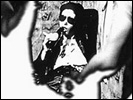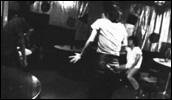Carnival of the Night
- Year
- 1983
- Original title
- Yami no Carnival
- Japanese title
- 闇のカーニバル
- Director
- Cast
- Running time
- 118 minutes
- Published
- 8 June 2006



by Johannes Schönherr
Is there really any movie that can "change your life" by seeing it? Well, I don't know. Maybe not. But there are certainly movies that are able to shift your interests in totally new directions. Carnival of the Night did exactly this for me.
I saw the film first in early 1986 as part of a special series called "Urban Landscapes" or some such at a small film festival in my then hometown of Nuremberg. The festival brochure announced it as "a movie like a knife attack" - which certainly made it sound greatly interesting, although generally I had little interest at all in films from Japan. Up until that time, all the Japanese films I had seen were either samurai dramas or yakuza gangster flicks, and they didn't win me over at all. I found them terribly boring and I just couldn't connect with them. I liked dirty, rotten, weird movies, preferably from the American underground.
In any case, I went to see the flick... and I was flabbergasted. These Japanese guys... they made movies better than anything I had seen from America! I couldn't believe my eyes! The film started off with color shots of busy Shinjuku daytime streets, accompanied by a creepy mix of distorted commercials on the soundtrack. The camera moves into the smaller streets, filled with garbage, and night sets, while the hand-held camera enters a dingy punk club. On stage, a young, cool looking woman sings a great cool song with her punk band playing along. Full ashtrays on the tables, people dozing on the couches, no cheering crowd at all. But as soon as she finishes that song and the scene moves backstage where the punk musicians start to drink and discuss where to score some weed, that one particular creepy and only half-conscious character we had seen pouring beer into ashtrays during the singing, suddenly erupts in a violent fit. For no reason, he starts to beat up people around him, throwing furniture at them, and all this is filmed from the perspective of someone who just happened to be there, witnessing what's going on without understanding any of it.
Meanwhile, the singer, whose name is Kumiko Ota, as the credits informed me, and who goes under the name Kumi in the movie (just like everybody in the film used their own names while playing their roles) says "Sayonara" to her band mates. She picks her small son up from a daycare center, reads a very kawaii good-night story to the kid at home... and arranges the same night by phone with her ex-husband, that he takes care of the kid for the next couple of days. They meet outside the Kinokuniya bookstore in Shinjuku - and yes, the ex-husband in the movie is the real ex-husband of Kumiko Ota and the son was theirs as I later learned. Kumi goes to the restroom of a nearby department store, changes clothes there... and the film changes from color to black-and-white.
Now, I don't want to tell the story as it unfolds in the movie. But I will mention a few especially memorable scenes here. Kumi borrows a gun from a guy who is working in a basement full of pipes for a Tokyo gas company and who is obsessed with finding the right spot to plant a bomb that will cause all the gas pipelines in the area to explode - and thus destroy the whole of Shinjuku. She tries out the gun, firing it from a pedestrian bridge in Nishi-Shinjuku straight into a phone booth - and the camera is inside that phone booth when the glass is shattered by the bullet. She meets up with that guy who turned violent at the club - he is an impotent drug addict and turns out much, much weirder and more violent than you would ever expect him to be. Downright crazy, nasty and destructive. Especially when he beats up that milk delivery guy and drags him through the shards of broken milk bottles. Ota has an incredibly hot dance scene at a dingy gay bar with rather violent customers... But no, I don't want to take the surprises away from you. There are so many truly strange things happening in the movie... you'd better watch it for yourself.
What I can tell is that everything in the movie felt incredibly immediate, just like walking into that proverbial wrong place at the wrong time. The noisy hand-cranked 16mm camera was constantly audible on the soundtrack and the movie felt like a documentary from hell, the worst scumbags of Tokyo filming their own nighly excesses. I was in paradise! I had finally found a movie that was almost perfectly in line with my own tastes! Weird, violent characters, an absolutely unpredictable storyline (see why I don't want to say more on how things develop in the movie?) and that indescribable feeling of roughness I was for always looking for in the movies.
The movie had played at the Forum section of the Berlin Film Festival in 1984 and at that time, all Forum films where picked up for German distribution by the Freunde der Deutschen Kinemathek, an arthouse rental outlet cum film archive. That's were the Nuremberg festival got the print from and that's where I kept ordering it from soon after I had seen Carnival for the first time. I was member of a Nuremberg cinema collective back then, called the Kino im KOMM. Now, the KOMM was the counterculture center of Nuremberg, a large building financed by the city and populated by punk rockers, junkies, winos and what have you, with concerts going on, with bars inside, with radical leftist groups active... and also with the Kino im KOMM cinema as part of it. Anything was possible at this cinema and I always tried finding especially strange films to throw into the faces of the audience. I booked Carnival there as often as I could but the film was generally not met with much appreciation. The KOMM may have been a weird counterculture outlet but to a good part, the people in charge were well-meaning social worker types and they just couldn't accept such a rough and nihilistic piece of cinema. I went ahead with the shows anyway till the nice guy at the distribution company (actually, that guy was Jürgen Brüning who later became the producer of all the Bruce LaBruce films) told me that the single print they had was too worn out to be rented out again. There obvious had been other cinema bookers obsessed with the pic as well.
Fast forward about ten years or so from that time. I didn't go straight to Tokyo after watching Carnival. No film can do that to you. I went to New York instead, repeatedly, building up my contacts with the underground scene there and eventually moving to live there. But Japan somehow always stayed in my mind - and when I was introduced to the great sashimi meals at a Lower East Side Japanese restaurant, I felt that Japan was really the place to go. Movies alone don't get me to places... but great food does! And a great love story would do even better... Now, I had that great love story with a Japanese girl in New York in early 1996 and she did arrange a Japan tour for me, me showing American underground shorts in a good number of cities in Japan in early 1997. I loved Japan at first sight - though, of course, it didn't look like the images from Carnival at all. But if I looked a bit closer... there were definitely a lot of strange things going on in Japan.
At around that time, the new government-financed Filmhouse in Copenhagen asked me for a series of Japanese underground movies to be shown at their facilities in Spring 1998. To make it cheaper to get the films over to Europe, they also wanted me to take the program to other cities and to split costs with the theaters there. I arranged the program for them and as they wanted to have some special guests from Japan, I invited Masashi Yamamoto, the director of Carnival of the Night.
Sixteen years had passed since he made that film but he sure showed off a punk attitude to boot. The translator I got him for his press interviews, a nice Japanese girl living in Copenhagen, was horrified and told me that "she had never met a Japanese guy like that before". He just attributed his strange and often plainly sexual remarks to everyone around to his "Osaka humor" - although he was actually from Oita Prefecture in Kyushu and now living somewhere in Saitama near Tokyo.
Actually, I did get along with Yamamoto fairly well. We went together to the hippie "free town" of Christiania a lot and he got stoned on the good hash the place is famous for while I got drunk on the cheap beer they serve there. We hung out with the Eskimo junkies, we talked about movies. He mainly wanted to promote his new film Junk Food (1998) with his visit to Copenhagen and that film also played in my series. Fine with me, I got him a lot of interviews with the Danish press for that one. But when we talked in private, I was only really interested in Carnival, the best movie he had ever made.
When it was time for him to leave, the Copenhagen Airport workers went on strike and we had to change Yamamoto's flight back to New York (where he was preparing another movie shoot - for a comedy this time) to leave from Hamburg. I had to go to Hamburg anyway for the next screenings of the "New Japanese Cult Cinema" as I had called the traveling movie series originating in Copenhagen. We drove to Hamburg together and spent one last night checking out the Reeperbahn sex district. Going to the stripper bars turned out to be a big rip-off but sitting out on the street at Hans-Albers-Place, downing whiskey while looking at the hookers was a treat. Too bad, no Christiania-style dope dealers there, we agreed.
Fast forward a few more years and I'm living here in Japan married to a woman I really love. I haven't seen Yamamoto in a long time and I don't know what's going on with his movies - if he still makes any. I wish him luck, though. He changed my life... well, sort of. He opened my mind towards Japan... and maybe I wouldn't be in Japan without him. Arigato gozaimasu, Yamamoto-san!